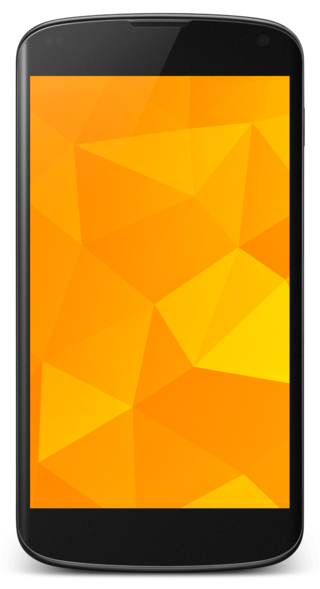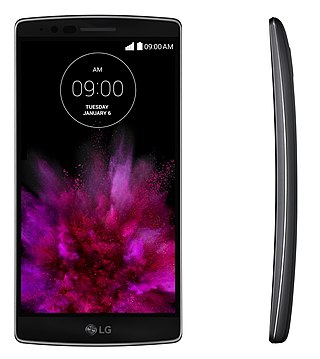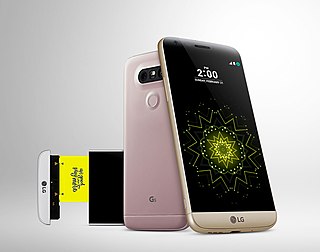
A smartphone is a mobile device that combines the functionality of a traditional mobile phone with advanced computing capabilities. It typically has a touchscreen interface, allowing users to access a wide range of applications and services, such as web browsing, email, and social media, as well as multimedia playback and streaming. Smartphones have built-in cameras, GPS navigation, and support for various communication methods, including voice calls, text messaging, and internet-based messaging apps.
Google Nexus is a discontinued line of consumer electronic devices that run the Android operating system. Google managed the design, development, marketing, and support of these devices, but some development and all manufacturing were carried out by partnering with original equipment manufacturers (OEMs). Alongside the main smartphone products, the line also included tablet computers and streaming media players; the Nexus started out in January 2010 and reached its end in October 2016, replaced by Google Pixel.

The Nexus 4 is an Android smartphone co-developed by Google and LG Electronics. It is the fourth smartphone in the Google Nexus product family, unveiled on October 29, 2012, and released on November 13, 2012, and succeeded the Samsung-manufactured Galaxy Nexus. As with other Nexus devices, the Nexus 4 was sold unlocked through Google Play, but was also retailed by wireless carriers.

The Samsung Galaxy Note series was a line of high-end flagship Android phablets and smartphones developed and marketed by Samsung Electronics. The line is primarily oriented towards pen computing; all Galaxy Note models shipped with a stylus pen, called the S Pen, and incorporate a pressure-sensitive Wacom digitizer. All Galaxy Note models also include software features that are oriented towards the stylus and the devices' large screens, such as note-taking, digital scrapbooking apps, tooltips, and split-screen multitasking. The line served as Samsung's flagship smartphone model, positioned above the Galaxy S series.

Moto X is an Android smartphone developed and manufactured by Motorola Mobility, and released in August 2013.

The LG G2 is an Android smartphone developed by LG Electronics. Serving as a successor to 2012's Optimus G and the 2013 Optimus G Pro phablet, the G2 was unveiled at a press event in New York City on 7 August 2013, and first released in September 2013. The G2 is primarily distinguished by software features that LG billed would "learn" from users, a high fidelity sound system designed to produce higher quality audio, a 5.2 in (130 mm) 1080p IPS LCD screen with technology that the company claimed would improve energy efficiency and reduce the size of the bezel around it, along with the unique placement of its power and volume keys—eschewing their typical location on the edge of a smartphone by placing them on the rear below the camera lens.

The Samsung Galaxy Note 4 is an Android smartphone developed and produced by Samsung Electronics. It was unveiled during a Samsung press conference at IFA Berlin on 3 September 2014 and was released globally in October 2014 as successor to the Samsung Galaxy Note 3. Improvements include expanded stylus-related functionality, an optically stabilized rear camera, 1440p quad-HD filming on the front camera, significantly increased charging rate, revised multi-windowing, and fingerprint unlocking. It is the last in the Samsung Galaxy Note series with interchangeable battery. Its subsequent model, the Samsung Galaxy Note 5, was unveiled on 13 August 2015.

Nexus 5 is an Android smartphone sold by Google and manufactured by LG Electronics. It is the fifth generation of the Nexus series, succeeding the Nexus 4. It was unveiled on October 31, 2013 and served as the launch device for Android 4.4 "KitKat", which introduced a refreshed interface, performance improvements, greater Google Now integration, and other changes. Much of the hardware is similar to the LG G2 which was also made by LG and released earlier that year.

The LG G Flex is an Android phablet developed and manufactured by LG. First unveiled by the company on October 27, 2013 for a release in South Korea, and carrying similarities to its G2 model, the smartphone is the company's first to incorporate a flexible display, along with a "self-healing" rear cover which can repair minor abrasions on its own.

The HTC One (M8) is an Android or Windows smartphone manufactured and marketed by HTC. Following a number of leaks that occurred during the months prior, the device was officially unveiled in a press conference on March 25, 2014, and released the same day by Verizon Wireless at retail, and by other Canadian and United States carriers for online orders prior to its wider retail availability in mid-April.

The Samsung Galaxy Alpha (SM-G850x) is an Android smartphone produced by Samsung Electronics. Unveiled on 13 August 2014, the device was released in September 2014. A high-end device, the Galaxy Alpha is Samsung's first Android-powered smartphone to incorporate a metallic frame, although the remainder of its physical appearance still resembles previous models such as the Galaxy S5. It also incorporates Samsung's new Exynos 5430 system-on-chip, which is the first mobile system-on-chip to use a 20 nanometer manufacturing process.

LG G Flex 2 is an Android phablet developed and manufactured by LG Electronics. First unveiled by the company on January 5, 2015, it is a successor to the original LG G Flex released in 2013. The design of the G Flex 2 resembles the LG G3, and as with the original, is differentiated primarily by its curved body and flexible display. LG announced several changes from the original G Flex design, including a smaller, higher-resolution display; reduced body curvature; stronger, chemically-treated screen glass; and a new iteration of the original's "self-healing" back cover that can more quickly repair minor abrasions.

The LG G4 is an Android smartphone developed by LG Electronics as part of the LG G series. Unveiled on 28 April 2015 and first released in South Korea on 29 April 2015 and widely released in June 2015, as the successor to 2014's G3. The G4 is primarily an evolution of the G3, with revisions to its overall design, display and camera.

The Samsung Galaxy Note 5 is an Android-based smartphone designed, developed, produced and marketed by Samsung Electronics. Unveiled on 13 August 2015, it is the successor to the Galaxy Note 4 and part of the Samsung Galaxy Note series.

The BlackBerry Priv is a slider smartphone developed by BlackBerry Limited. Following a series of leaks, it was officially announced by BlackBerry CEO John Chen on September 25, 2015, with pre-orders opening on October 23, 2015, for a release on November 6, 2015.

The LG G5 is an Android smartphone developed by LG Electronics as part of the LG G series. It was announced during Mobile World Congress as the successor to the 2015 LG G4. The G5 is distinguished from its predecessors by its aluminum chassis and a focus on modularity. Its lower housing, which holds the user-replaceable battery, can be slid from the bottom of the device, and replaced by alternative add-on modules that provide additional functions. Two modules are available: a camera grip, and a high-fidelity audio module with DAC. A lower-spec variation, dubbed the LG G5 SE, is available in some markets.

BlackBerry DTEK is an Android smartphone co-developed and distributed by BlackBerry Limited, and manufactured by TCL. DTEK comprises two models: DTEK50 which is a modified and rebranded variant of TCLs Alcatel Idol 4 ; and DTEK60 which is a modified and rebranded variant of TCLs Alcatel Idol 4S. The DTEK models are the second and third Blackberry Android phones after the Blackberry Priv. Like the Priv, the DTEK Android operating system is customized with features inspired by those seen on Blackberry's in-house operating systems, and with hardware and software security enhancements.

LG V20 is an Android phone manufactured by LG Electronics, in its LG V series, succeeding the LG V10 released in 2015. Unveiled on September 6, 2016, it was the first phone with the Android Nougat operating system. Like the V10, the V20 has a secondary display panel near the top of the device that can display additional messages and controls, and a quad DAC for audio. The V20 has a user-replaceable battery, unlike its successor, the LG V30, unveiled on 31 August 2017.

The LG G8 ThinQ is an Android smartphone developed by LG Electronics as part of the LG G series. It was officially announced on February 24, 2019. The device serves as the successor to the 2018 LG G7 ThinQ 4G.

The LG V50 ThinQ, commonly referred to as the LG V50, is an Android phablet manufactured by LG Electronics as part of the LG V series. It was announced in February 2019 and is the successor to the LG V40 ThinQ.






















